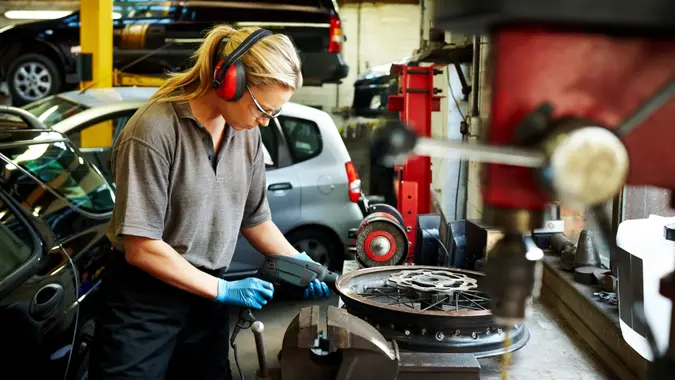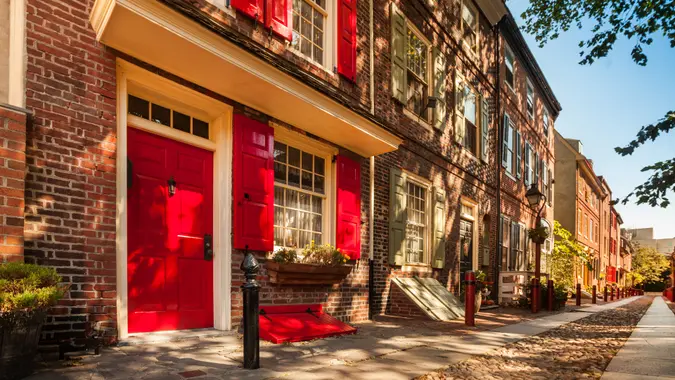I’m an Auto Flipper: 6 Ways To Make Money Reselling Cars

Commitment to Our Readers
GOBankingRates' editorial team is committed to bringing you unbiased reviews and information. We use data-driven methodologies to evaluate financial products and services - our reviews and ratings are not influenced by advertisers. You can read more about our editorial guidelines and our products and services review methodology.

20 Years
Helping You Live Richer

Reviewed
by Experts

Trusted by
Millions of Readers
Joyce K. has been flipping cars for eight years, and she’s turned it into a serious side hustle that brings in an extra $20,000 to $30,000 annually. What started as a way to make some quick cash between jobs has become a well-oiled machine (pun intended) for finding undervalued vehicles, fixing them up and selling them for profit. Now, as she approaches retirement, she believes it will be her main income moving forward.
“Most people think car flipping is just about buying low and selling high and I wish it were that simple,” Joyce explained. “I’d be rich! But you need to understand exactly what people are looking for, and that’s never easy.”
That said, Joyce does have some proven methods that often work. Here are her six favorite ways to make money reselling cars.
The ‘Motivated Seller’ Strategy
Joyce’s bread and butter involves finding people who need to sell their cars quickly due to life circumstances. They might be moving for a job or going through a divorce. These are people who need to get rid of their cars — and fast.
“I check Craigslist, Facebook Marketplace and OfferUp every single morning,” Joyce said. “I’m looking for specific phrases like ‘must sell this week,’ ‘moving out of state’ or ‘need gone ASAP.’ These sellers are usually willing to take less than market value for a quick sale and that’s where I come in.”
Joyce focuses on cars priced 15% to 25% below Kelley Blue Book value that don’t appear to have major mechanical issues. She’s learned to spot the difference between a motivated seller and someone trying to dump a problem vehicle.
“If the ad says ‘ran when parked’ or ‘just needs a small repair,’ that’s usually code for ‘this car is going to cost you thousands,'” she shared. “But if someone says ‘clean title, runs great, just need to sell quickly,’ that’s when I get interested.”
The Auction Game
Joyce discovered that many people are intimidated by car auctions, which creates opportunities if you’re willing to do your homework.
“I go to dealer auctions about twice a month, but I spend way more time preparing than I do actually bidding,” she explained. “I research every car I’m interested in ahead of time … what they’re selling for in my area, what common problems to look out for and what the real market demand is like. It’s not no work, but I kind of like doing it. I find that’s key … you have to enjoy it.”
Her secret weapon is focusing on cars that dealers don’t want. This includes vehicles that are too old for their lots but still have plenty of life left for individual buyers.
“Dealers want cars that are 3 to 5 years old because that’s what most of their customers are looking for,” Joyce said. “But there’s a huge market for reliable 8- to 12-year-old cars that families can actually afford. That’s where I make most of my money.”
Fixing Up the Fixer Uppers
Joyce shared that this isn’t about hiding the car’s “problems,” it’s about making cost-effective improvements to increase its value.
“I’m not a mechanic, and I don’t pretend to be one,” Joyce said. “But I’ve learned that a really good detail job, new floor mats and fixing small cosmetic issues can add $2,000-3,000 to what someone’s willing to pay.”
Her typical “flip prep” includes professionally detailing the car, replacing floor mats, fixing small dents, replacing bulbs and adding air freshener — yes, people like that “new car smell.”
The Seasonal Timing Play
Yes, according to Joyce, cars have “seasons.”
“I buy convertibles and sports cars in fall and winter when nobody wants them, then sell them in spring and summer,” she said. “Same thing with trucks and SUVs. I stock up on those in summer and sell them before winter when people need reliable vehicles for bad weather. This isn’t an exact science, but it’s just something I’ve noticed.”
This strategy requires patience and some upfront capital to hold inventory, but Joyce said the payoff is worth it.
The First Car Market
Joyce says the “first car” market for new drivers is flourishing and shouldn’t be ignored.
“Parents want cars that are safe and reliable for their teenagers, but they don’t want to spend $20,000,” she shared. “If I can sometimes find a good Honda Civic or Toyota Corolla with around 100,000 miles for $4,000 to $5,000, I can usually sell it for $7,000 to $8,000 to a parent who knows their kid is going to ding it up anyway.”
The key is focusing on brands with reputations for reliability and avoiding anything too flashy or powerful.
Getting Creative Online
Time for a road trip! If you’re willing to do the research and spend the time, Joyce said you can make money by buying in smaller towns and selling in larger ones.
“I’ve bought cars on Craigslist in smaller towns and sold them on AutoTrader in bigger cities for 20% to 30% more,” she shared. “Urban buyers are often willing to pay more for convenience and selection, while rural sellers might not know what their car is really worth in a bigger market.”
She also watches for cars that are listed on the wrong platform for their target audience.
“A few times I’ve found real gems on Craigslist priced way too low,” Joyce explained. “Sometimes sellers just don’t know what they’re doing.”
Do It Yourself
After years of trial and error, Joyce has developed some non-negotiable rules that anyone looking to get into auto flipping can follow. First, she never buys a car she can’t afford to; this might mean she misses out on some deals but it’s simply not worth it to her. She also locks in exactly how much she’s willing to spend before she heads online or to an auction, and she doesn’t deviate from it.
If she pays more than $10,000 for a car, she’ll have a mechanic do a thorough inspection before she buys it. She says this $150 can save her big in the long run.
And finally, she keeps impeccable records. “The IRS considers this a business and so do I.”
More From GOBankingRates
 Written by
Written by  Edited by
Edited by 

























